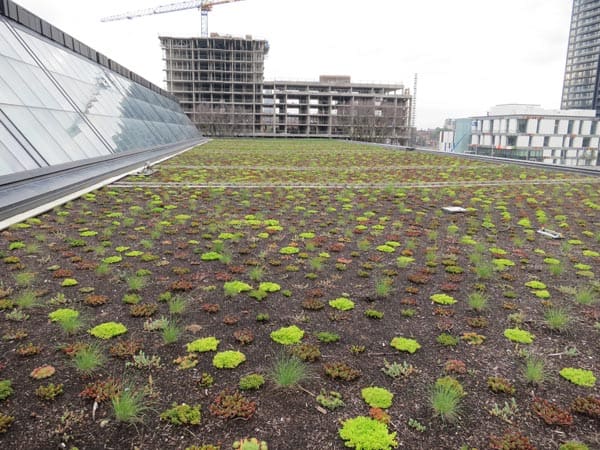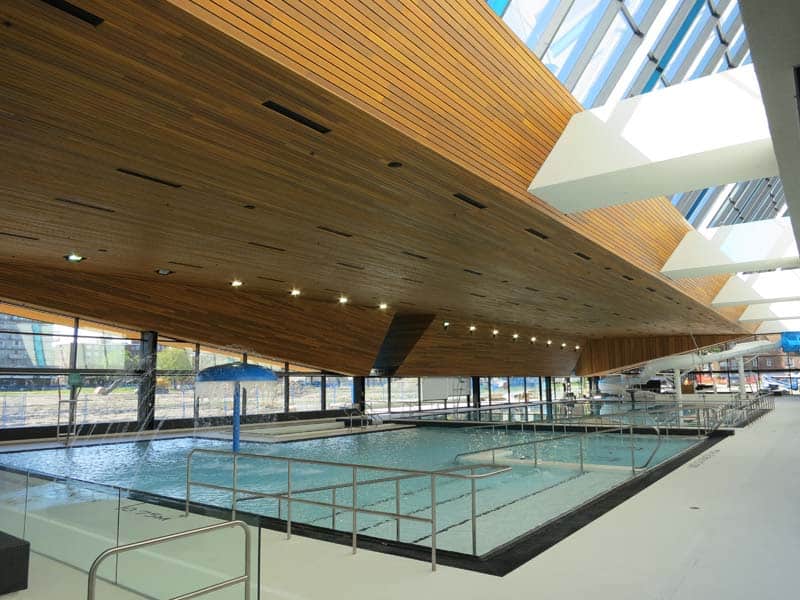Let’s give a shout-out to good neighbours: local facilities, businesses, organizations, and initiatives that are going above and beyond to serve their communities. Take, for example, the new Regent Park Aquatic Centre.
“Beacon” is not necessarily a word that you might use to describe a pool. But then again, you may not yet be familiar with the newly opened Regent Park Aquatic Centre, situated right in the heart of Regent Park. In this climate, few things seem to capture the spirit of optimism and growth as much as the Aquatic Center. And most of the people I’ve spoken to about the pool (from the staff, to the community’s citizens, to the pool’s supervisor Gary Sanger) have had a hard time describing it as anything short of a “beacon”—of community, inclusiveness, and accessibility—in a former ghetto.
First, there’s the design. The nearly 30k sq. ft. area that encompasses the indoor pool and its adjacent outdoor park is stunning, particularly when compared with the dilapidated state of the buildings it replaced. According to Sanger, Architects MJMA wanted this iconic look for the site; the resulting design is predominantly stark black and white, with cedar paneling and translucent blue accents. The effect is one of openness, cleanliness, and warmth.
Then there are the pools. The first of the site’s three main pools is the spa tub with staggered jets, offering a nearly-full-body massage (!). The second is the “kiddie” or “leisure” pool, featuring two different depths to suit the needs of both toddlers and pre-schoolers, as well as another massage-jet-seating-area for guardians to relax in whilst keeping an eye on the little ones (can you tell Sanger has kids?). Finally, there’s the main pool, complete with lane swimming, a diving board, a waterslide (which deposits riders in a small shallower pool, making it accessible for the more tentative swimmers), and most uniquely, a Tarzan rope!
Not to leave any stone unturned, the Aquatic Centre is even utilizing the roof space. On top of the pool tank itself, they’ve planted a huge green garden full of succulent plants. Although it won’t be visible from the street, it will provide a lovely view of the surrounding buildings (more of which are going up all the time), and photos of the garden will be used to decorate the lobby of the Centre.
Keeping with the pool’s emphasis on green space, on the west side of the building are six tall sliding glass windows, which, in conjunction with a skylight, not only provide the centre with an abundance of natural light, but will also connect the pool with the adjoining park (which will be completed by fall 2013). This indoor/outdoor concept is a first for a Toronto pool, but it is totally in conjunction with the spirit of the project. In regards to any kind of design challenge, Sanger says “we just said, ‘Let’s do this here,’ and then figured out a way to get it done.”
Which leads to the exemplary and incredibly forward-thinking way in which the pool has considered the community in its construction and programming: co-ed change rooms (allowing families to stay together, as well as accommodate transgendered and transitioning populations), and gender-specific swim times (with built-in screens that cover the windows for added privacy). And not only is the Centre appealing to Regent Park’s residents; the affordable ($2) entrance fee has made the facility appealing to Torontonians from all over the city, helping to bridge the gap between the neighbourhoods.
Although there are many things to applaud about Regent Park Aquatic Centre, I am perhaps most heartened by Sanger’s outlook on the way the community programming can create opportunities for youth in the area. “I look forward to when 14-year-old children become 16 and take their National Lifeguard and Instructor exams,” he says. “That is going to be an exciting time for us, when we actually see the benefits of having a facility built: giving children the opportunities to learn to swim and become lifeguards, and having them stand on that deck, working as life guards for the community.”




 Follow Us On Instagram
Follow Us On Instagram
